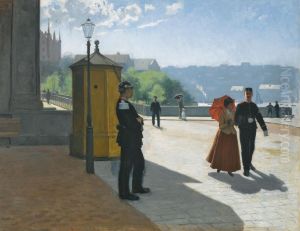Carl Axel Hedelin Paintings
Carl Axel Hedelin, a Swedish painter born in 1815 and deceased in 1893, was a notable figure in the 19th-century Swedish art scene. His life and work were deeply intertwined with the cultural and artistic milieus of his time, reflecting the broader trends and shifts in European art during the era. Hedelin's journey into the arts began at an early age, influenced by the rich historical and natural landscapes of Sweden. His early experiences with the Swedish countryside and its historical sites would later permeate his artistic endeavors, imbuing his works with a sense of place and history that was distinctly Swedish.
Hedelin pursued formal art education at the Royal Swedish Academy of Arts, where he honed his skills and developed a keen interest in landscape painting and historical subjects. This education provided him with the foundational techniques and the exposure to art historical traditions necessary for his future career. Throughout the 1840s and 1850s, Hedelin emerged as a prominent figure in the Swedish art scene, participating in exhibitions and gaining recognition for his work. His paintings often depicted scenes from Swedish history and folklore, executed with a detailed realism and a sensitivity to light and atmosphere that was characteristic of the period's artistic sensibilities.
Despite the acclaim he received, Hedelin's career was marked by a constant struggle for artistic recognition and financial stability, a common plight for many artists of the time. He traveled extensively throughout Europe, seeking inspiration and the opportunity to study the works of other artists. These travels influenced his artistic development, exposing him to various styles and movements that he would later incorporate into his own work. Hedelin's contributions to Swedish art were not limited to his paintings; he was also involved in the cultural debates of the time, advocating for the importance of art and its role in society.
Upon his death in 1893, Carl Axel Hedelin left behind a legacy that was appreciated more in retrospect. His works, which had captured the spirit and landscapes of Sweden, became valued for their historical significance and artistic merit. Today, Hedelin is remembered as an important figure in the history of Swedish art, whose paintings offer a window into the cultural and historical narratives of 19th-century Sweden. His dedication to portraying the beauty and complexity of his homeland continues to inspire artists and art enthusiasts alike, securing his place in the annals of art history.
